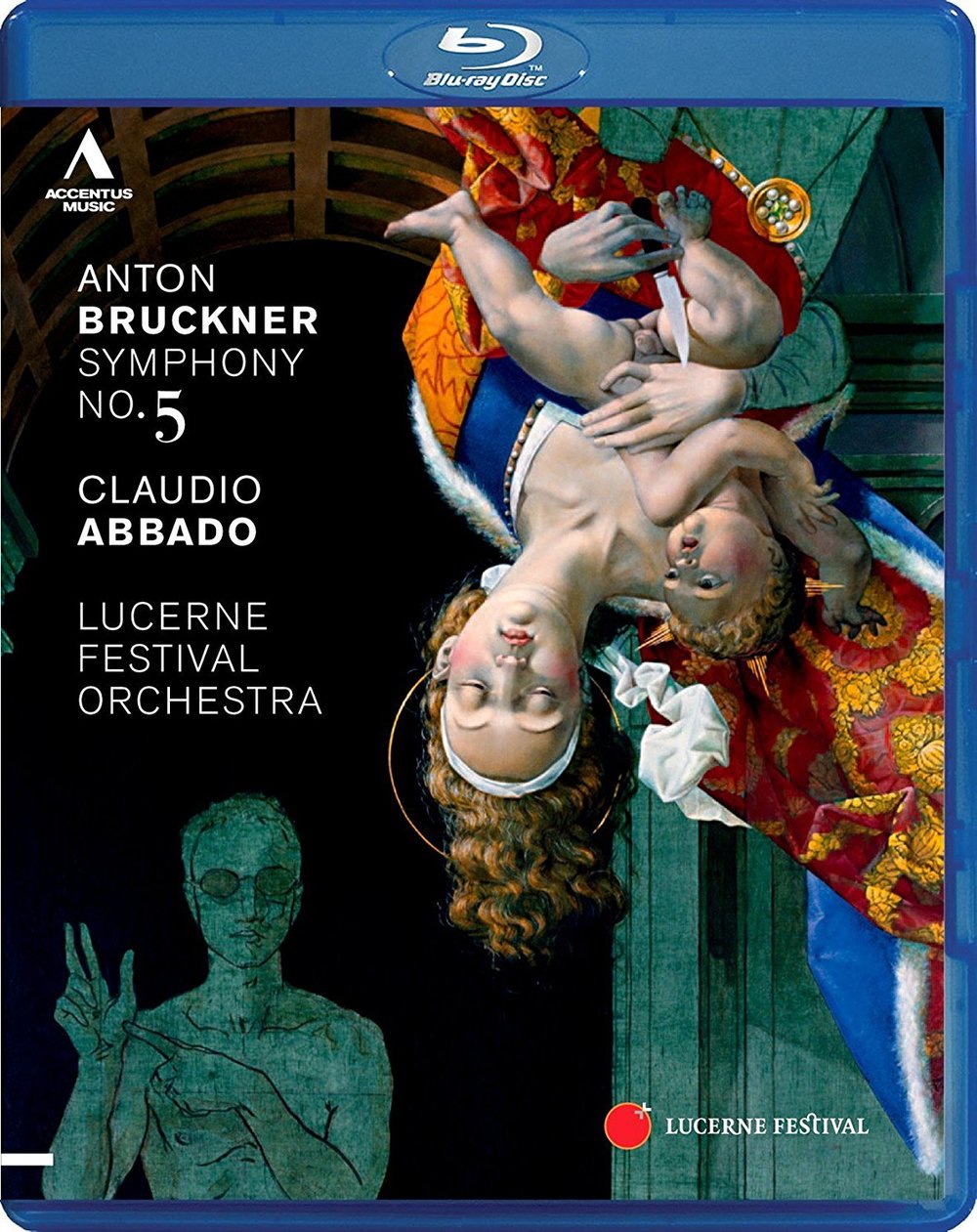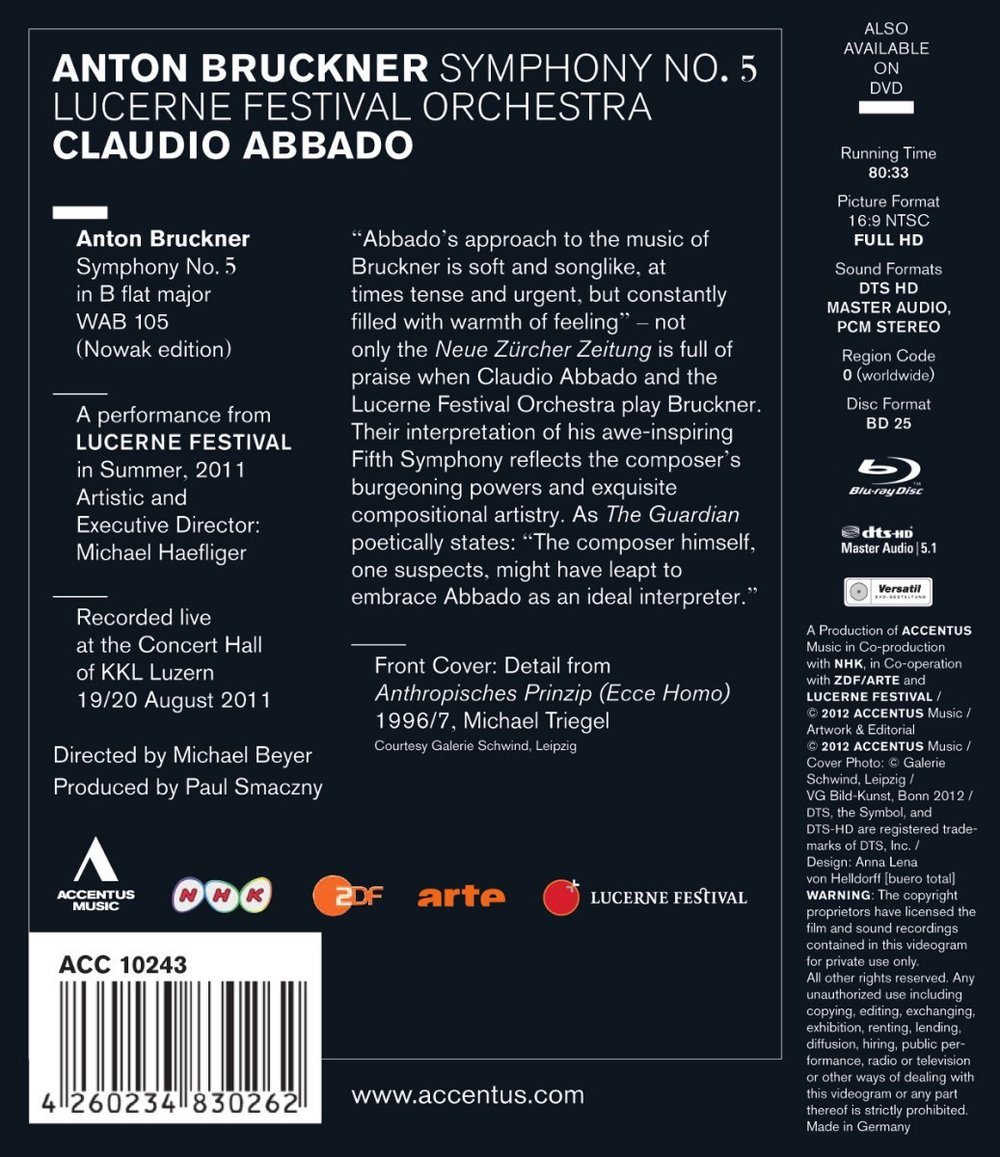

Bruckner Symphony No. 5. Claudio Abbado conducts the Lucerne Festival Orchestra at the 2011 Lucerne Festival. Unusual contemporary artwork on the package by Michael Triegel. Directed for TV by Michael Beyer; Andrej Nicolay was Director of Photography; produced by Paul Smaczny. Released 2012, disc has 5.1 dts-HD Master Audio sound. Grade: C+
In its 2012 Awards Special Issue, Gramophone called this the year's best DVD (page 55). The awards article doesn't even mention that a Blu-ray was available, so we surmise that the Gramophone critic watched the DVD. We bought the Blu-ray to review long ago, but it never got to the top of our “to do” list. We always agreed that the musical performance and sound recording are excellent. But we had reservations about video content. Some time has passed since we last talked about DVDitis in symphony recordings, so we think it’s timely to bring this up again for our new readers.
First let’s consider how we classify screenshots of a symphony performance. The first image below is an “architectural shot”. It’s mostly designed to show off the beautiful venue. There’s a place for this, but we condemn this if it prevents us from getting something much more important: a proper, long, whole-orchestra (WO) shot early in the video.
In the architectural shot below you get to see where the double-bass section is, but that’s about it. This is a bad start. We want our WO view soon as possible so we can see where all the musicians are sitting. You would be astonished if we could show you how many symphony videos fail to provide this orientation:
Right away we get the view next below. Is this a WO image? No. This is an amateurish stab at it perhaps, but it doesn’t get all the players and the angle is way too low — this view is a waste of time:
Finally after more than 3 minutes of frustration, we get the WO image seen below! Now we can use our remote control to freeze this shot and take a look around. We count 9 basses, 14 violas, 5 horns, 4 bassoons, etc. We see the violins in a huge mass on the left and the cellos seated in an archipelago across the center of the stage. When you attend a live symphony performance, you usually get plenty of time during the tune up to see how the player are placed on the stage. The videographer should in every case provide a similar opportunity to the HT viewer with a WO shot right after the musical performance begins, but it’s astounding to see how often this simple courtesy is ignored:
The next shot below is a part-orchestra (PO) view. This shot allows us to see large numbers of players in different sections working together. The PO view is large-scale image that’s often as good or even better than a WO shot, depending on who is playing at the time:
Moving in closer, below is a nice shot of the cello section. True, we are missing some members. But if the picture includes more than half of the players in a large section, we count it as a large-scale shot:
And next below is a valuable multi-section shot, also large-scale. One hallmark of a good HDVD video will be the presence of many WO, PO, large-scale, and multi-section shots:
But most of the clips in a typical Blu-ray symphony video will be relatively close-in showing 4 or fewer players a time. Some of them get really intimate like the picture of the clarinet player below. We call these small-scale shots. It is a hallmark of a DVD of a symphony to have mostly small-scale shots showing only a tiny portion of the orchestra. For more information why this is so, see our Special Story on standards for grading Blu-ray symphony videos:
We will not bore you here with another category of clip which shows you the front of the conductor from the waist up. But we will warn you that many Blu-ray symphony videos have a ton of conductor-over-backs-of-musician shots like the 3 views next below. We consider these shots to be abominations because they don’t show the conductor well and also insult the musicians, who should always be photographed from the front and not from the rear:
And too often there are other weak-to-worthless shots throughout the video that result from lack of care in framing, focus errors, and the like. Professional musicians simply don’t make errors that a member of the audience could perceive. Why should videographers be allowed framing errors like these?
We use a Wonk Worksheet to keep track, clip by clip, of the content of the disc being reviewed. By dividing the number of clips into the number of seconds in the title, we get the average length of each clip, which we call the “pace” of the recording.
Over the years we stumbled onto some 15 symphony discs that we found to be extraordinarily pleasant and easy to watch. From these recordings we extracted the follow basic notions: the best symphony Blu-ray recordings have (1) long clips (a slow pace), (2) many long-range views of the orchestra, (3) only a modest number of close-ups shots, (4) only limited views of the front of the conductor, (5) no shots of the conductor over the backs of musicians, and (6) few framing and focus errors. For a detailed explanation of this, see our special story on Standards for Grading Orchestra Videos.
For this review of the Abbado Bruckner 5, we ran the numbers on movements 1 and 2. We could tell this was representative of the whole disc, so we saved time by not scoring movements 3 and 4. The pace is about 8.5 seconds per clip. The large-scale clips, which we call supershots, make up only 13% of the clips. Conductor shots make up 28% of the views.
We then apply the following tests to the numbers we came up with:
“Stated briefly, a good HDVD should have a slow pace with more than 10 seconds per video clip on average (longer the better). 20 to 40% (higher is better) of the clips should be large-scale "supershots" (whole-orchestra, part-orchestra, multiple-section, and large-section shots). Conductor shots should be less than 20% (way less really) of the clips in the video.”
So now you can see that subject Bruckner 5 disc flunks all three tests: the pace is too fast at 8.5 seconds per clip, only 13% of the clips are large-scale supershots, and there are way too many conductor shots. Our diagnosis is virulent DVDitis , and this knocks our grade from A+ to D+! We mean business! But because the title is so good otherwise, we will move the grade by up to a C+.
So what is going on here? The entire industry (except for NHK) has pretty much stuck to making DVDs of the symphonic performances they record. Then they dress the DVDs in Blu-ray hot pants to sell as an auxiliary profit center to customers with Blu-ray players. The labels can say (tongue in cheek) that the Blu-ray is a better product. But in fact the pimped-out Blu-ray is vastly inferior to what it should have been if the videographer had shot a file that took full advantage of HD technology. Accentus, Arthaus, Berliner Philharmoniker, C Major, DG, EuroArts, RCO Live, etc. have cranked out about 300 symphony discs in the last decade of which about 3% are valid HDVD recordings. To us, the remaining 97% are part of a colossal charade.
The people in the industry are fully aware of all this. They continued to make DVDs because more customers were buying DVDs than Blu-rays. The reason for the continued popularity of the DVDs is that too many viewers didn’t find the difference between the DVDs and the Blu-rays to be compelling. But now that we have 4K Blu-rays and HDR, we believe customers for fine-arts material will see that the 4K/HDR recordings are vastly better than the old DVDs. When this day comes, the industry will have to start gearing up to reshoot everything correctly!
Here's a (SD) YouTube clip that itself suggests that subject title has DVDitis. Of the 29 clips we count in this clip, 21 are characteristic of DVDs and only 4 are the kind of large-scale views we treasure in our HDVDs:
OR












